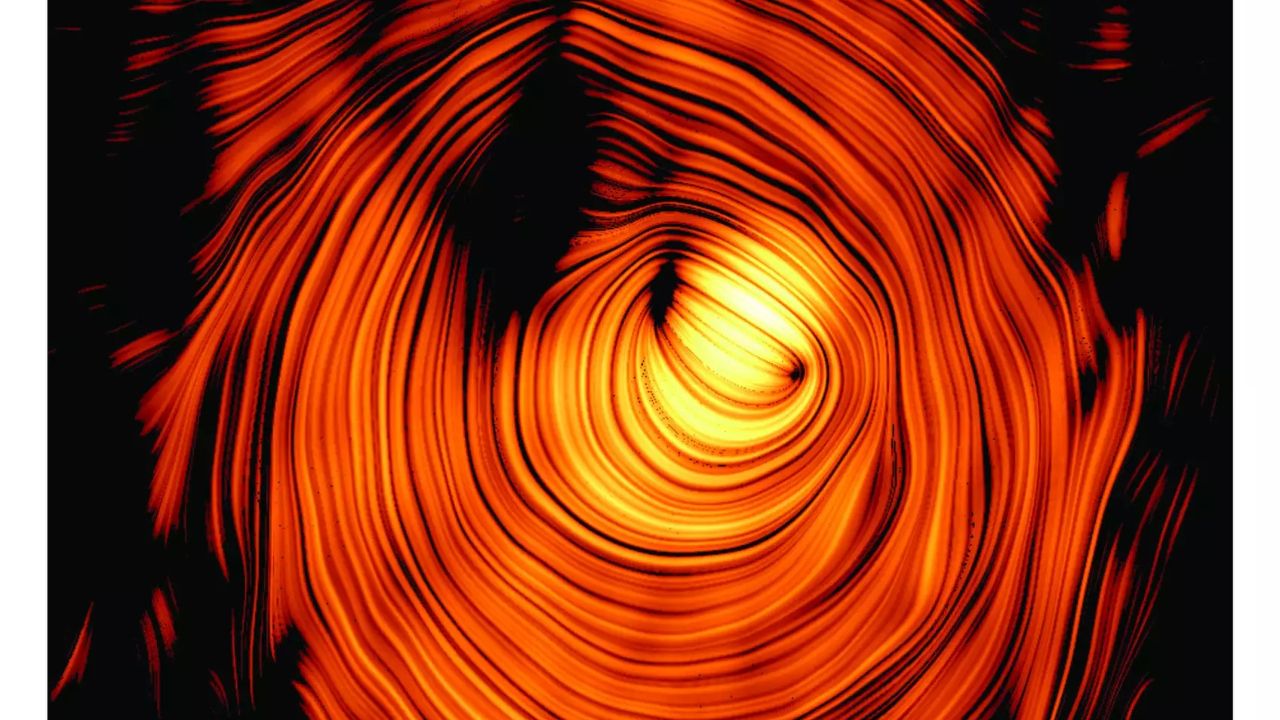Science
Astronomers Capture Stunning Image of Blazar Resembling Sauron’s Eye

A team of astronomers has successfully reconstructed an extraordinary image of a blazar—an astronomical phenomenon that bears an uncanny resemblance to the fictional “Eye of Sauron” from J.R.R. Tolkien’s *The Lord of the Rings*. This remarkable achievement comes after nearly 15 years of data collection by a powerful radio telescope located on Earth, focusing on a distant point in the universe approximately billions of light-years away.
Blazars are a specific type of quasar, which are incredibly bright centers of active galaxies powered by supermassive black holes. These black holes can emit energetic jets of particles moving at nearly the speed of light. Quasars themselves can outshine all the stars in their host galaxies, but blazars present a unique perspective when their jets point within 10 degrees of Earth. This alignment significantly amplifies their brightness.
Unveiling the Blazar
When the research team, led by Yuri Kovalev from the Max Planck Institute for Radio Astronomy (MPIfR), reconstructed the image, they were astonished by the results. “When we reconstructed the image, it looked absolutely stunning,” Kovalev stated, highlighting the near-perfect toroidal magnetic field and the jet directed straight at Earth. This orientation can increase the brightness of a blazar by a factor of 30 or more, according to co-author Jack Livingston.
The blazar in question, designated PKS 1424+240, may rank as one of the brightest sources of high-energy gamma rays and cosmic neutrinos ever recorded. Neutrinos, often referred to as “ghost particles,” are elusive subatomic particles that traverse the universe and pass through ordinary matter without interaction. Trillions of these particles flow through the human body every second, remaining undetected due to their non-interactive nature.
The IceCube Neutrino Observatory, located in Antarctica, originally discovered PKS 1424+240 due to its exceptionally high neutrino emission levels. This finding highlights the potential of active galactic nuclei, powered by supermassive black holes, as not just accelerators of electrons but also protons, which are significant in the production of high-energy neutrinos.
Implications for Astronomy
The reconstruction of this blazar image not only provides a stunning visual representation but also allows astronomers to delve deeper into the mechanics of these powerful cosmic entities. Kovalev noted that the findings confirm the dual role of active galactic nuclei in accelerating both electrons and protons, thereby clarifying the origins of the high-energy neutrinos emitted by PKS 1424+240.
A study detailing these groundbreaking results was published on August 12, 2023, in the journal Astronomy & Astrophysics Letters. The insights gained from this research could pave the way for further understanding of the dynamics at play in some of the universe’s most energetic phenomena, revealing the intricate workings of blazars and their impact on the cosmos.
This latest discovery not only enriches our understanding of blazars but also underscores the advancements in astronomical technology that allow for such detailed observations of the universe. As researchers continue to explore the vastness of space, phenomena like PKS 1424+240 provide tantalizing glimpses into the mysteries that lie beyond our planet.
-

 Technology4 months ago
Technology4 months agoDiscover the Top 10 Calorie Counting Apps of 2025
-

 Health2 months ago
Health2 months agoBella Hadid Shares Health Update After Treatment for Lyme Disease
-

 Health3 months ago
Health3 months agoErin Bates Shares Recovery Update Following Sepsis Complications
-

 Technology3 weeks ago
Technology3 weeks agoDiscover 2025’s Top GPUs for Exceptional 4K Gaming Performance
-

 Technology2 months ago
Technology2 months agoElectric Moto Influencer Surronster Arrested in Tijuana
-

 Technology4 months ago
Technology4 months agoDiscover How to Reverse Image Search Using ChatGPT Effortlessly
-

 Technology4 months ago
Technology4 months agoMeta Initiates $60B AI Data Center Expansion, Starting in Ohio
-

 Technology4 months ago
Technology4 months agoRecovering a Suspended TikTok Account: A Step-by-Step Guide
-

 Health4 months ago
Health4 months agoTested: Rab Firewall Mountain Jacket Survives Harsh Conditions
-

 Lifestyle4 months ago
Lifestyle4 months agoBelton Family Reunites After Daughter Survives Hill Country Floods
-

 Technology3 months ago
Technology3 months agoUncovering the Top Five Most Challenging Motorcycles to Ride
-

 Technology4 weeks ago
Technology4 weeks agoDiscover the Best Wireless Earbuds for Every Lifestyle









